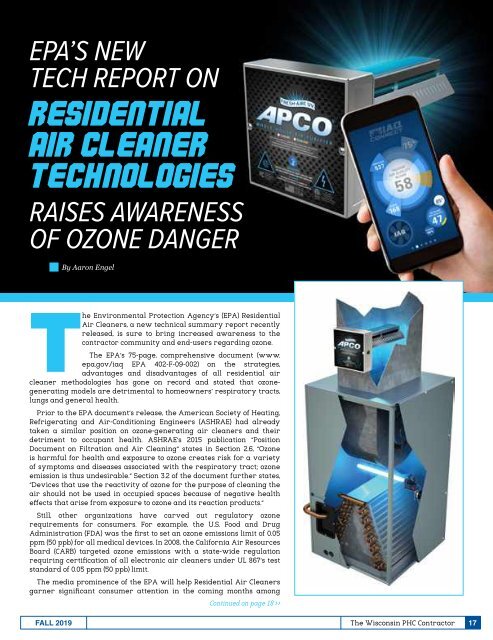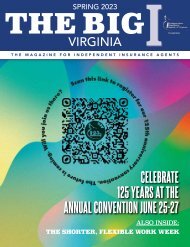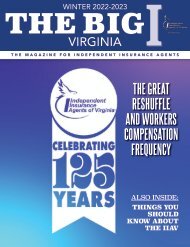Wisconsin PHC Contractor Fall 2019
Create successful ePaper yourself
Turn your PDF publications into a flip-book with our unique Google optimized e-Paper software.
EPA’S NEW<br />
TECH REPORT ON<br />
RESIDENTIAL<br />
AIR CLEANER<br />
TECHNOLOGIES<br />
RAISES AWARENESS<br />
OF OZONE DANGER<br />
By Aaron Engel<br />
The Environmental Protection Agency’s (EPA) Residential<br />
Air Cleaners, a new technical summary report recently<br />
released, is sure to bring increased awareness to the<br />
contractor community and end-users regarding ozone.<br />
The EPA’s 75-page, comprehensive document (www.<br />
epa.gov/iaq EPA 402-F-09-002) on the strategies,<br />
advantages and disadvantages of all residential air<br />
cleaner methodologies has gone on record and stated that ozonegenerating<br />
models are detrimental to homeowners’ respiratory tracts,<br />
lungs and general health.<br />
Prior to the EPA document’s release, the American Society of Heating,<br />
Refrigerating and Air-Conditioning Engineers (ASHRAE) had already<br />
taken a similar position on ozone-generating air cleaners and their<br />
detriment to occupant health. ASHRAE’s 2015 publication “Position<br />
Document on Filtration and Air Cleaning” states in Section 2.6, “Ozone<br />
is harmful for health and exposure to ozone creates risk for a variety<br />
of symptoms and diseases associated with the respiratory tract; ozone<br />
emission is thus undesirable.” Section 3.2 of the document further states,<br />
“Devices that use the reactivity of ozone for the purpose of cleaning the<br />
air should not be used in occupied spaces because of negative health<br />
effects that arise from exposure to ozone and its reaction products.”<br />
Still, other organizations have carved out regulatory ozone<br />
requirements for consumers. For example, the U.S. Food and Drug<br />
Administration (FDA) was the first to set an ozone emissions limit of 0.05<br />
ppm (50 ppb) for all medical devices. In 2008, the California Air Resources<br />
Board (CARB) targeted ozone emissions with a state-wide regulation<br />
requiring certification of all electronic air cleaners under UL 867’s test<br />
standard of 0.05 ppm (50 ppb) limit.<br />
The media prominence of the EPA will help Residential Air Cleaners<br />
garner significant consumer attention in the coming months among<br />
FALL <strong>2019</strong><br />
Continued on page 18 >><br />
The <strong>Wisconsin</strong> <strong>PHC</strong> <strong>Contractor</strong><br />
17


















